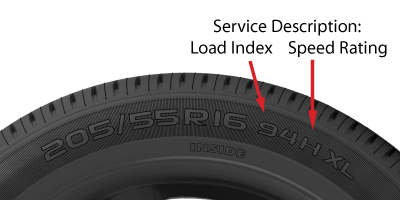Last Updated on April 21, 2024
Understanding the Importance of Tire Load Index for Safe and Efficient Driving
When ensuring your vehicle’s safety and performance, one often overlooked factor is the tire load index. This essential information can significantly impact how your car handles different loads, making it a critical consideration when purchasing new tires.
In this guide, we’ll delve into the world of tire load index, helping you understand what it means and why it matters for your driving experience.
Unlocking the Significance of Tire Load Index
Imagine you’re planning a road trip with friends, and you’re excitedly packing your car with luggage, camping gear, and everything you need for a memorable adventure. As you load up your vehicle, you may not realize that the weight you add places a specific demand on your tires. This is where the tire load index comes into play.
What Is the Tire Load Index?
The tire load index is a numerical code found on the sidewall of your tires, typically following the tire’s size designation. It represents the maximum weight a single tire can support safely when properly inflated. This weight is measured in pounds or kilograms and corresponds to a specific load index number.
Deciphering Load Index Ratings
Load index ratings typically range from 0 to 279 for passenger car tires. The higher the number, the greater the tire’s load-carrying capacity. For example, a tire with a load index of 90 can support 1,323 pounds, while a load index 110 can carry 2,337 pounds.
The Load Index Chart
Load index ratings typically range from low numbers like 75 to higher ones like 126 for passenger car tires. As the numbers increase, so does the tire’s load-carrying capacity. For example, a tire with a load index of 75 can support 853 pounds, while a tire with a load index of 126 can carry a whopping 3,748 pounds.
Matching Load Index Ratings
When it’s time to replace your tires, the critical rule to remember is to select tires with a load index rating that matches or exceeds what your vehicle manufacturer recommends. For instance, if your vehicle’s tires have a load index 94, you can replace them with those rated 94, 95, and so on. However, never choose tires with a lower load index rating, such as 93 or lower, as they won’t safely handle your vehicle’s weight.
It’s Not About the Chart
While there are comprehensive load index charts available, what’s essential for you to know is that you should always match or exceed the load index rating on your existing tires when buying replacements. This ensures that your new tires can adequately handle the weight of your vehicle and any additional load you might carry.
Why Does the Load Index Matter?
Now, you might be wondering why the load index is so crucial. It directly impacts your vehicle’s safety, handling, and performance. Using tires with a load index that’s too low for your car and its typical load can lead to several problems:
- Reduced Safety: Overloading your tires can cause them to overheat, potentially leading to a blowout.
- Poor Handling: Tires with insufficient load capacity may affect your vehicle’s steering and cornering abilities, making it less stable on the road.
- Shortened Tire Life: Overloaded tires wear out more quickly, reducing their lifespan and requiring you to replace them sooner.
How to Find Your Vehicle’s Load Index
To determine the appropriate load index for your vehicle, check your car’s owner’s manual or the placard on the driver’s side door jamb or inside the glove compartment. It provides essential information about your vehicle’s recommended tire size and load index.
- Consult Your Owner’s Manual: Your car’s owner’s manual is valuable for information about your vehicle’s specifications, including the recommended tire size and load index. It often contains a section dedicated to tire specifications and maintenance guidelines.
- Check the Placard: Look for a placard on your vehicle, typically located on the driver’s side door jamb or inside the glove compartment. This placard displays essential details, including the recommended tire size and load index, specific to your vehicle’s make and model.
- Refer to the Tire Sidewall: If you already have tires on your vehicle and wish to confirm the load index, you can find this information on the tire’s sidewall. It is typically represented as a numerical value within the tire’s size specifications. Match the load index to the recommendations in your owner’s manual or on the placard.
- Online Resources: Some tire manufacturers and automotive websites offer online tools and calculators to help you determine your vehicle’s appropriate tire size and load index. Input your vehicle’s make, model, and year; these tools can provide tire recommendations based on your specific requirements.
- Consult a Tire Professional: If you’re unsure about your vehicle’s correct load index or tire size, consider seeking advice from a tire professional or an automotive expert. They can provide personalized recommendations based on your driving needs and vehicle specifications.
Remember that the load index is a crucial factor in ensuring your tires can safely support the weight of your vehicle and its passengers. Using the correct load index enhances safety and optimizes tire performance and longevity.
Choosing the Right Tires
Now that you understand the importance of the tire load index, you can make more informed decisions when buying tires. When selecting new tires, always opt for ones with a load index equal to or greater than your vehicle manufacturer recommends. This ensures that your tires can handle the weight of your vehicle and any additional load.
Selecting the right tires for your vehicle is a critical decision that directly impacts safety and performance. Here are some key considerations to keep in mind when choosing tires:
- Load Index: As discussed earlier, refer to your vehicle’s owner’s manual or the driver’s side door jamb placard for the recommended load index. Always choose tires with a load index equal to or greater than the manufacturer’s recommendation to ensure your tires can handle the weight of your vehicle and any added cargo.
- Tire Size: The correct tire size is crucial for your vehicle’s handling and safety. Refer to the above sources for the recommended tire size. Make sure the tire size matches your vehicle’s specifications.
- Driving Conditions: Consider the typical driving conditions you encounter. All-season or winter tires may be better if you live in an area with frequent rain or snow. For off-road adventures, you might need specialized off-road or all-terrain tires.
- Tire Type: Tires come in various types, including summer, all-season, winter, and performance tires. Choose a type that aligns with your driving needs and climate.
- Budget: Determine your budget for new tires. While high-quality tires often come with a higher price tag, they offer better performance and durability. However, there are budget-friendly options available that still provide reliable performance.
- Brand and Reviews: Research tire brands and read reviews to get insights from other drivers. Trusted brands with positive reviews are more likely to offer reliable products.
- Tire Warranty: Check the warranty offered by the tire manufacturer. A good warranty can provide peace of mind in case of any unexpected issues.
- Professional Advice: If unsure about your vehicle’s best tire choice, consult a tire professional or visit a tire shop. They can offer expert guidance based on your specific needs.
Remember that your tires are crucial to your vehicle’s safety and handling. Investing in high-quality, adequately matched tires is an intelligent decision that ensures a smoother and safer driving experience.
Cracking the Code: Understanding Tire Load Index for Safe Driving
How much weight your vehicle can carry is essential in determining the right tires for your car or truck. The service description of the tire size indicates both the speed and load indexes. See the graphic below to identify this area of the tire size:
With the tire load index, you need to pay attention to putting the same or higher load rating on your vehicle when replacing your tires. The numbers work based on a chart; the “94” in the picture above represents the tire that can handle a 1,500 lb. load; with four tires, the vehicle’s capacity is 6,000 lbs.
So if your tire has a “94” load index, you can replace it with a “94”, “95”, etc.; however, you would not put a 93 or lower load index on your vehicle, as the tires would not be sufficient to handle the load capacity of the car.
I could put a fancy chart here that shows all the load indexes, but it’s huge and not what’s important to know about this area of the tire size. The most important thing to know when buying new tires is to ensure they have the same or higher index rating. Otherwise, your tires won’t be able to handle the load.
Conclusion
The tire load index may seem like a small detail, but it plays a significant role in keeping you safe on the road and ensuring your vehicle’s optimal performance. Consider this crucial factor when buying tires, and you’ll enjoy a smoother, safer, and more enjoyable driving experience.
Ready to find the perfect tires for your vehicle?
Please browse our selection of high-quality tires at Tire Easy, where safety and performance meet. Take the first step toward a better driving experience today!
FAQs
What is the load index on a tire?
The load index on a tire is a numerical code that indicates the maximum weight-carrying capacity of that specific tire. It is essential information for ensuring the safe operation of your vehicle, as it helps you determine whether the tire can support the weight of your car and any additional cargo.
What does tire load index 94 mean?
A tire load index of 94 means that the tire can carry a maximum load of 1,477 pounds (or 670 kilograms) when adequately inflated and used per the manufacturer’s guidelines. This rating helps vehicle owners understand the tire’s weight-carrying capacity and select the appropriate vehicle tires.
How do you read a tire load index?
Reading a tire load index is relatively straightforward. It is a numerical code that typically ranges from 70 to 126. Each number corresponds to a specific weight-carrying capacity in pounds or kilograms. You can find this code on the sidewall of your tire and match it to a load index chart provided by the tire manufacturer or vehicle manufacturer to determine the tire’s capacity.
What is a vehicle load index?
A vehicle load index refers to the combined load-carrying capacity of all the tires on a specific vehicle. It considers each tire’s load index and calculates the total weight the vehicle can safely carry. To maintain safety, it’s essential to ensure that the tires’ load index on your car matches or exceeds the manufacturer’s recommendations.











